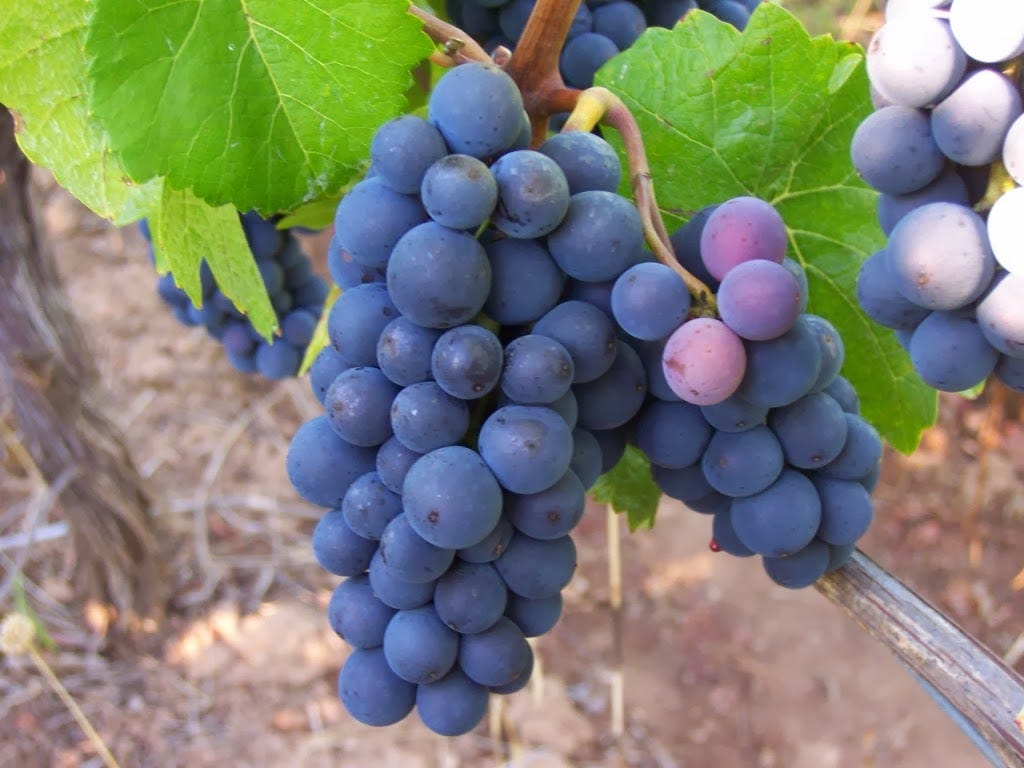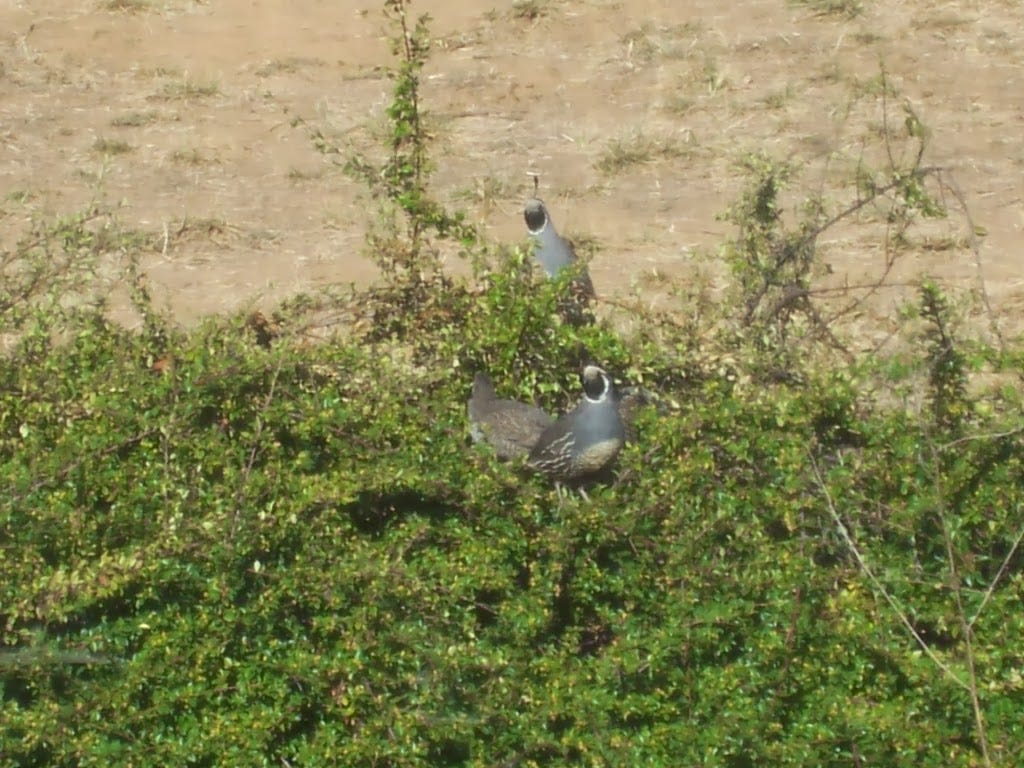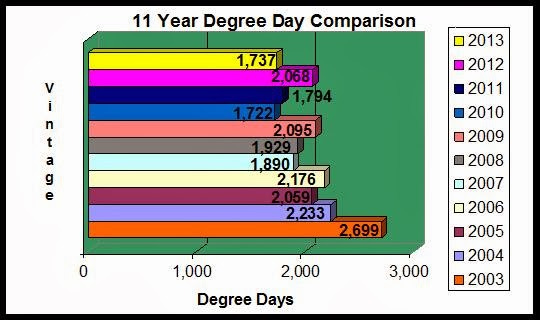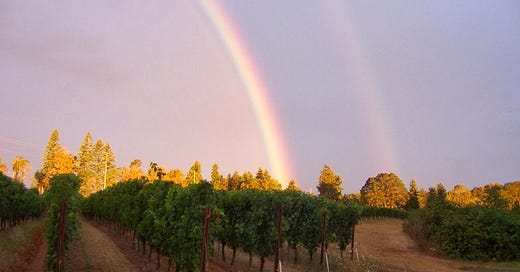Amalie Robert Estate Climate Update: 2013 August
Hello and Welcome,
This is the climate summary for the month of August 2013 (Julian calendar days 213-243 inclusive.)
They say the line between genius and insanity is a thin one. We would add that in winegrowing this relationship is in a constant state of flux dependant upon the weather. And the final product, even years down the road, is repeatedly subject to interpretation.

August has been such a month. We have had very warm days with dry breezes from the east. The mornings have sometimes blessed us with a heavy onshore flow from the coast providing humidity and cloud cover, and on the 15th an early morning double rainbow over Block 2. The evening sunsets and the full moon have been stunning. And we have even had the “R” word. Yep, a little bit of rain to close out the month. But to get a true read on the vintage, we need to pay attention to the underlying fundamentals – night time temperatures which have been warm.
For us, the line between unripe fruit and wonderfully expressive flavors and aromas in Pinot Noir occurs at about 105 days after flowering. In that other Pinot Noir growing region, Burgundy, they only need about 100 days to cross the threshold. So what gives? The nights in Burgundyare typically a little warmer, and even a little increase in temperature adds up over 100 days.
But what does this mean and why should I care? It means that during the day the leaves are carrying on photosynthesis and exporting that energy through the vascular tissue to the rest of the plant. This is how the vine is building sugars in the wineberries. However, the leaf can generate much more energy than it can export during the daytime hours.

As nightfall approaches the temperatures begin to drop. The leaf is still trying to export energy back into the vine, and will continue to do so until the temperatures drop down to below 50 degrees Fahrenheit. At that point, the vascular tissue is too cold to continue transporting energy from the leaves. The leaves are left to store the energy until the temperature rises.
As the sun rises and greets the vines, the leaves are once again photosynthetically active. However, the leaves are still storing energy from the day before. This limits the amount of photosynthesis that can occur each day, and in turn increases the number of days necessary to ripen the fruit. Now, 100 v 105 days may not seem like much, but try holding your breath for 5 days. It makes a difference.

But wait, there’s more! As part of the Pinot Noir cluster, we have the wing. This little, or sometimes large, appendage has got to go. Here’s why. The wing flowers about a week after the main cluster and therefore ripens about a week late. We would prefer not to have the unripe flavors from these berries in our wine, so we nip them off. That’s about a minute per vine by 45,000 vines. That’s pretty easy farmer math.

Now let’s talk about ripeness. What does it really mean? We look at it from two points of view. The first is the scientific analysis. We measure the fermentable sugars, primarily Fructose and Glucose, represented as Brix. We know that we will convert sugars to alcohol at a rate of about 60%. So if we have 20 Brix in our fruit, we will end up with about 12% alcohol. If we see 25 Brix it means we waited a bit too long and are peddling 15% alcohol Pinot Noir. Those are the rules of the road.

Acids are great and we measure those with a pH meter. For those of you who skipped high school chemistry, like Ernie, just remember the lower the pH the more acidic the wine will be. A microbial stable wine will be somewhere between 3.0 and 3.7 pH, the lower the better for extended aging. That is why wines from cool, character building vintages like 2005, 2007, 2010 and 2011 may need a little more time to tell their stories than warmer, more accessible vintages.
Once the numbers tell us we are “in the zone” we can get onto more subjective evaluations. The objective here is to understand what the wineberries taste and smell like. Think of the grape skin as a little flavor and aroma packet. Our job as wine growers is to use the 105 days of ripening to influence how those flavors and aromas will develop. We have several tools at our disposal including removing leaves to increase sun exposure, or not. We hedge the canopy to help accelerate ripening or let the shoot tips grow to slow down the ripening process. Cover crops and grasses play a role by taking up excess moisture when they are allowed to grow tall. Not so much when Ernie lowers the flail for a tight trim.
It also helps to keep the crystal ball in good repair so as to factor in what Mother Nature has planned. Obviously, we spend a lot of time in the vineyard tending to the vines. It keeps us off the streets, but we can only dance to the music she plays. And our station is WTFR (Waft The Fruit Radio) where the hits keep on coming.
So, there it is. The canopy is still looking very green and healthy. The wineberries are turning from green to mauve to purple. We are trimming off excess crop and the late to ripen wings. We are also waiting for a spot of rain to soften up the rows in the vineyard so Ernie doesn’t have to buy a new rototiller this year. Then the summer cover crop gets turned into the soil and we put down about 50 pounds per acre of Winter Peas to fix nitrogen and Rye Grass to hold it until the Spring when the cycle starts over again. No chemical fertilizer here, we grow our own!
Of course, everyone has an opinion on the upcoming vintage quality. It is said that only journalists can know the quality of a vintage before the grapes are actually harvested. That may be true, but we also have our own “Peanut Gallery.”

These guys and hens are constantly in the vineyard. Mostly they are eating the Buckwheat seeds from the summer cover crop mix. But they pop off quite often and loudly. We usually get an earful at the breakfast table, as there favorite spot to orate is in the shrubbery between the kitchen and block 2. They also have their own rabbit. He, or she, seems to be quite shy and we have yet to see an appropriate suitor on the scene.

And Peaches is still running around here somewhere. Ernie was discing the “Upper West Side” getting ready for a spring planting of Wadenswil clone when he saw this beautiful doe running along the inside of the new deer fence. Her coat was the most amazing color of a Redtail hawk’s tail feather. Not much to worry about in the vineyard just now, so Ernie geared down on the crawler and let her by. Since Ernie’s encounter, Peaches has been a bit shy, so we’ve issued a “Missing Peaches Report.” We expect she is getting ready for the rut and will be back in fine form just as the grapes ripen up.

Before we get to the numbers, we wanted to remind everyone that if you are doing any home repairs or remodels, you need one of these. This basic model has a handle for red and a handle for white. However, with just a little more effort you can find a model that will provide several choices to match your mood. We do recommend that if you are addicted to bubbles like Dena, the traditional glass bottle and tree bark stopper is the proper way to go.
And here are the numBERRRRs!
We have recorded 524 degree days for the month of August, providing a total of 1,737 degree days since the beginning of the growing season on April 1, 2013 (Julian calendar day 91.) For analytical comparative purposes only, the 2010 vintage only recorded 1,722 degree days through the end of OctoBERRRR.

Silky, sexy wines they are, with relatively low alcohol. When Ernie was in Dublin, the Irish guys would say “You can’t drink all day if you don’t start in the morning.” If that is the case, then 2010 is the vintage.
Crunch ‘em if you got ‘em, and Ernie does. Looking at the first 15 days of August we see a high of 92.0 degrees and a low of 47.2 degrees, with an average temperature of 66.39 degrees. This is from the optimally positioned weather station that takes a temperature reading every 20 minutes. The next 16 days of August provided a high of 89.3 degrees and a low of 50.6 degrees, with an average temperature of 67.31 degrees from the aforementioned, optimally positioned, weather station. The second half of August also brought a shot of rain and heavy cloud cover that held the daytime heat through the evening hours.
Here is what we can glean from these numbers:
R The high temperatures are well below the levels that will shut down the vine and potentially sunburn overexposed berries.
R The low temperatures tell us that the vines are continuing to export energy from the leaves during the evening hours. This is advancing the ripening curve and reducing the number of days the vine needs to build sugars.
R Conversely, the vines are reducing the potential number of days we need to achieve flavors and aromas in the skins due to an advanced ripening trajectory.
R We may not be able to wait the full 105 days to start harvest operations. Good news for you. You may only need to hold your breath for 3 days instead of 5.
Based on the date the vines flowered plus 105 days, a harvest window opens on day 262 of the Julian calendar (aka Thursday, September 16.) However if September continues on August’s course, we may be forced to begin harvest a little early to avoid high potential alcohol wines. What a change this would be from 2010 and 2011 where we were still harvesting well into NovemBERRRR.
August rainfall occurred from the 25th thru the 29th and totals 0.29 inches. While not a significant amount of rain, this event is significant as we typically do not see rain in August. It was a welcome sight as we have been pretty warm and dry since our last rain event on June 30th. Total rain for the growing season is now 13.37 inches.
Here is what we had to say last year, August 2012:We have recorded about 545 degree days for the month of August, providing a total of 1,474 degree days since the beginning of the growing season on April 1st. This compares with 582 degree days last August and a comparative total of 1,271 degree days for 2011. Ceteris Paribus for August, but we are still holding our degree day advantage from the Spring.
Our high temperature was 101.0 and Ernie’s hi-tech, wireless weather gauge chose this day to display “OFL.” We couldn’t agree more, it was awful! Our low temperature for the month was 45.4 degrees Fahrenheit. There was no rainfall in August. Rainfall last August was also zero. Rainfall since April 1st through August 30th remains 8.96 inches, and is 0.43 inches less than last year's growing season to date rainfall of 9.39 inches.
Kindest Regards,
Dena & Ernie



